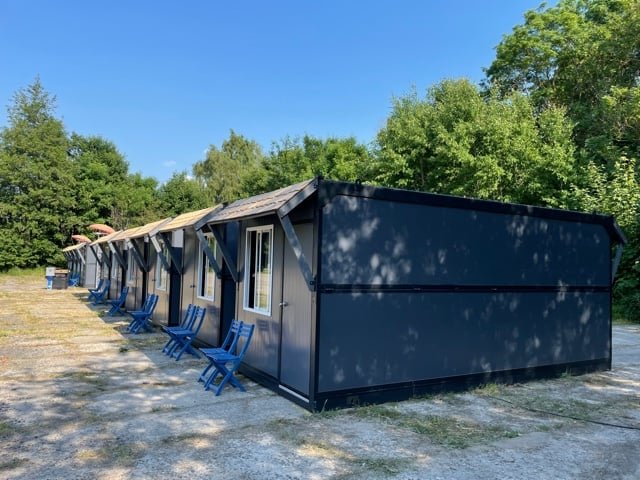Folding container houses utilize several key materials to achieve durability, energy efficiency, and versatility. The primary structural framework is often made from galvanized steel, ensuring robustness and corrosion resistance. Aluminum composite panels are used for cladding, while various insulation materials, such as glass wool and polyurethane, enhance thermal performance and comfort.
Folding container houses are a combination of strength and flexibility and modern engineering, but what exactly is in these new homes? Let’s dig deeper into the materials.

What materials are used to build folding container houses?
Primary Structural Materials
- Steel Framework:
The foundation for most folding container houses is a steel structure, most commonly made from galvanized steel or corten steel. Galvanized steel has a protective zinc coating that helps prevent rust, while corten steel is known for being weather-resistant, making it perfect for backwoods or city dwelling applications. - Aluminum Composite Panels:
For the external cladding, you will normally see them using aluminum composite panels simply because they’re light and they’re really resistant to rust. These panels not only (look great but) add to the aesthetic appeal of the house but also provide additional protection from the elements.
Insulation Materials
- Glass Wool:
Glass wool is a popular choice for insulation, especially in the roof and wall panels. It offers good thermal resistance and is naturally fire-retardant, making it a practical option for enhancing energy efficiency. - Polyurethane and Rock Wool:
In higher-end folding container house designs, polyurethane or rock wool may be used. Polyurethane, in particular, offers a higher R-value, which means better thermal insulation compared to other materials. This ensures that the home remains comfortable in both hot and cold climates.
Interior Finishing Materials
- Plywood Flooring:
Typically, the flooring of folding container houses is made of marine-grade plywood, which is known for its strength and resistance to moisture. It’s laid over the steel frame to ensure a solid, stable base. - Drywall or Insulated Panels:
Interior walls may be finished with drywall or additional insulated panels, depending on customer requirements. These materials help create a comfortable living space and provide options for customizing the interior look.
Roofing Materials
- Corrugated Metal Sheets:
The roof is often constructed from corrugated metal sheets, which are both lightweight and strong. These sheets may have an arched design to facilitate efficient water drainage and improve overall structural integrity. - Roof Insulation Layer:
To enhance energy efficiency, an insulation layer, such as glass wool, is typically placed beneath the roofing material. This helps regulate the temperature inside the container, reducing the need for additional heating or cooling systems.
Additional Features
- Windows and Doors:
Folding container houses can be equipped with different types of windows and doors, often framed with metal for added durability. These elements can be customized according to user preference—whether for security purposes or to enhance natural lighting. - Protective Coatings:
The steel framework may also be treated with coatings like electro-galvanization or polyurethane topcoats. These coatings are applied to improve the corrosion resistance and durability of the structure, ensuring it stands up to various environmental conditions.
And, in summary, they’re built with a combination of robust materials including galvanized steel for the framework, glass wool and polyurethane for energy efficiency, and plywood for a sturdy floor. This combination allows these homes to not only be tough but also adaptable, able to survive in a variety of environments and climates.
How will these little houses hold up in severe weather?
Everything about folding container houses is built to be durable. With materials like corten steel and galvanized steel, they won’t rust or weaken so they can tolerate the most severe of weather conditions. Many times, you’ll notice that they also put in really big steel braces to help them resist hurricanes and put in heavy insulation panels to help them perform in extreme cold and hot weather.
What are the main benefits of using steel in folding container houses?
They use steel as the core material for these houses because it won’t bend when you put a heavy load on it. Also, galvanized steel does not rust or corrode, which is extremely important for houses that are located in tropical and coastal environments. Finally, the modular nature of steel components makes it easy to put these structures together and take (them) apart, when you want to move.
How do folding container houses compare to traditional houses when it comes to cost?
In general, folding container houses are less expensive than traditional houses. The main reason is because they use modular steel frames and heavily mass-produced components which drives the cost of the construction down. And because they are prefabricated, there are fewer surprises when you’re building it, they can throw them up quicker, which means you’re going to save money on the labor.
Can folding container houses be customized with different architectural styles?
Yes, customization is a significant advantage of folding container houses. From exterior finishes like aluminum cladding to different roofing styles and door options, these houses can be tailored to meet personal tastes or functional requirements. Clients can also choose custom layouts and add features such as decks or balconies for added aesthetic appeal.
What are the typical uses for folding container houses besides residential purposes?
Besides being utilized as residential homes, folding container houses are commonly used as temporary offices, emergency shelters, and pop-up shops. Their quick installation and portability make them perfect for applications in disaster-stricken areas or for construction site accommodation where flexibility is key.
In Conclusion
Folding container houses are a modern answer that is a blend of durable, affordable, and customizable. They are made with strong products like galvanized steel and insulated with several options. They are built to last and can adapt to many different uses. These are a very efficient way to build something instead of building it the way we did in the old days.




